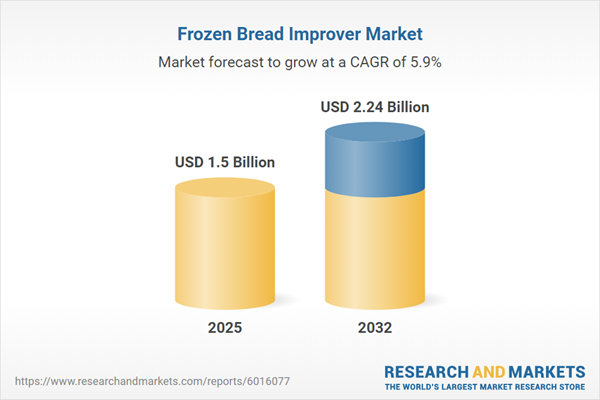Speak directly to the analyst to clarify any post sales queries you may have.
The frozen bread improver market is evolving as suppliers innovate to meet changing industry requirements, focusing on quality, convenience, and operational efficiency. Senior leaders increasingly rely on targeted analysis to anticipate challenges, identify responsive opportunities, and maintain competitive advantage in this dynamic sector.
Market Snapshot: Frozen Bread Improver Market Growth and Trends
The frozen bread improver market continues on a robust growth trajectory, with recent periods marked by accelerated expansion and a healthy compound annual growth rate. Demand remains steady across both consumer and professional baking segments, as suppliers refine their product offerings and operational processes. This market landscape is fostering steady innovation, prompting manufacturers to integrate advanced formulas and meet rising expectations in reliability, texture, and overall product performance. Market participants influence operational best practices by addressing the unique requirements of end users ranging from home bakers to industrial-scale producers, thereby enhancing the overall competitiveness and standardization within the frozen bread improver industry.
Scope & Segmentation: Frozen Bread Improver Market Opportunities
- Format Types: Gel, liquid, and powder formulations deliver operational flexibility and enable manufacturers and bakers to achieve consistent batch quality and customized outcomes tailored to each baked product.
- Application Categories: Bread improvers play a central role in a variety of baked goods, including bagels, buns, English muffins, rolls, and different bread types, making them essential in both artisanal and industrial baking methods.
- Core Functions: Key purposes include improving dough conditioning, enhancing crust and crumb color, extending shelf life, and advancing texture while supporting reliability and efficiency in bakery operations.
- End Users: Frozen bread improver solutions target artisan bakeries, household users, and high-volume industrial producers, emphasizing broad applicability and scalability for any production environment.
- Distribution Channels: Primary routes to market are direct sales, foodservice supply networks, and retail channels, ensuring accessibility for both commercial and consumer buyers in the value chain.
- Key Regional Markets: Each region—Americas, Europe, Middle East & Africa, and Asia-Pacific—presents its own consumer habits and regulatory landscape, driving market-specific innovations and compliance approaches.
- Technology Adoption: Increasing use of microencapsulation, precision ingredient blending, advanced enzymes, and blockchain-based tools is improving product consistency, traceability, and regulatory compliance across supply networks.
Key Takeaways for Decision-Makers
- Clean-label initiatives remain pivotal as demand rises for bread improvers with plant-derived or naturally sourced ingredients, aligning with evolving labeling and branding strategies.
- Collaboration with R&D and packaging teams supports steady innovation, especially in extending product stability and aligning formulations with consumer expectations.
- Resilient procurement and streamlined production processes reduce vulnerability to changes in regulations or logistics, supporting continuous delivery and stable supply.
- Ongoing digitalization enhances quality control, traceability, and regulatory compliance, inspiring trust among buyers and reinforcing supply chain transparency.
- Well-adapted product lines that cater to various scales of bakery operations deliver long-term value, ensuring market longevity and operational efficiency across segments.
Tariff Impact and Strategic Responses
Recent changes in US tariffs on certain imported ingredients have raised operational costs for producers dependent on enzyme and emulsifier blends sourced from Europe and Asia. In response, many companies are strengthening domestic manufacturing capabilities, diversifying their sourcing strategies, and establishing alliances with regional suppliers. These actions underscore the value of building resilient, agile supply chains equipped to adapt to evolving global trade dynamics.
Methodology & Data Sources
This analysis synthesizes primary insights from executive interviews across ingredient sourcing, industrial baking, and specialty manufacturing sectors. Rigorous secondary research using leading industry publications and up-to-date regulatory sources also informs the findings. Each data point is validated by expert review to ensure strategic relevance for senior decision-makers tasked with guiding operational performance and growth.
Why This Report Matters for the Frozen Bread Improver Market
- Delivers comprehensive segmentation, regional intelligence, and technology adoption analysis to guide strategic decisions.
- Outlines actionable frameworks for optimizing supply chain resilience and innovation, helping organizations adapt to regulatory shifts and consumer preferences.
- Enables stakeholders to identify and capture value across every segment of the frozen bread improver supply chain, supporting operational excellence.
Conclusion & Forward Perspectives
This report provides senior leaders with authoritative recommendations and forward-thinking perspectives, supporting confident planning and informed investment as the frozen bread improver market evolves further.
Additional Product Information:
- Purchase of this report includes 1 year online access with quarterly updates.
- This report can be updated on request. Please contact our Customer Experience team using the Ask a Question widget on our website.
Table of Contents
3. Executive Summary
4. Market Overview
7. Cumulative Impact of Artificial Intelligence 2025
Companies Mentioned
The companies profiled in this Frozen Bread Improver market report include:- Puratos Group NV
- International Flavors & Fragrances Inc.
- Kerry Group plc
- Koninklijke DSM N.V.
- Corbion N.V.
- Novozymes A/S
- Associated British Foods plc
- Lallemand Inc.
- Lesaffre Groupe
- Chr. Hansen Holding A/S
Table Information
| Report Attribute | Details |
|---|---|
| No. of Pages | 189 |
| Published | October 2025 |
| Forecast Period | 2025 - 2032 |
| Estimated Market Value ( USD | $ 1.5 Billion |
| Forecasted Market Value ( USD | $ 2.24 Billion |
| Compound Annual Growth Rate | 5.9% |
| Regions Covered | Global |
| No. of Companies Mentioned | 11 |









